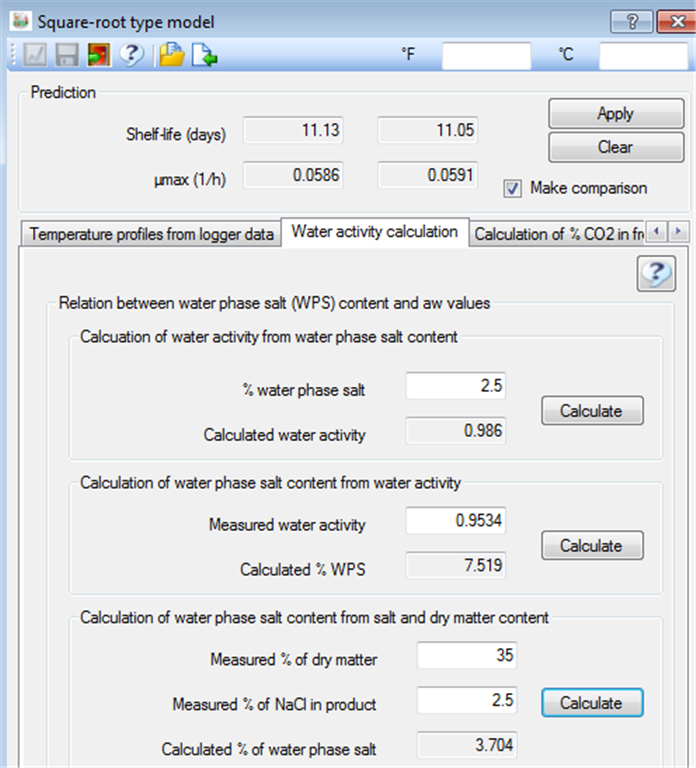|
|
| Model | Microbial spoilage models with user-defined parameter values: Square-root-type model |
| Reference | Dalgaard,
P., Cowan, B.J., Heilmann, J. and S. Silberg 2003. The Food Spoilage
and Safety Predictor (FSSP). In: Predictive
Modelling in Foods - 4th
International Conference Proceedings. Van Impe, J.F.M., Geeraerd, A.H.,
Leguérinel, I., Mafart, P. (eds.) 15-19 June
2003, Quimper, France. pp 256-258.
Ross, T. and P. Dalgaard 2004. Secondary models.
In: McKeller, R.C., Lu, X. (Eds.), Modeling Microbial Responses in Foods. CRC
Press, Boca Raton, USA, p 76. |
| Primary growth model | Log-transformed 3-parameter Logistic model |
| Secondary growth model | Square-root-type model |
| Environmental parameters in model | Temperature, % CO2 (equilibrium concentration), water activity (aw) and pH |
| Product validation studies | Not studied - depends on microorganisms and selected model parameter values (See other MS models in FSSP) |
| Range of applicability | Not studied |
This FSSP model with user-defined parameter values can compare growth and shelf-life for: i) two microorganisms with known and different cardinal parameter values when growing under a given set of storage conditions and product characteristics. ii) a single microorganisms with known cardinal parameter values when growing under different storage conditions and/or different product characteristics (temperature, equilibrium CO2 concentration in MAP, water activity and pH) In both cases, growth under constant or fluctuating temperature conditions can be compared. The secondary square-root-type growth model used by FSSP is shown in Eqn. 1. The model includes a constant (b) and the cardinal parameters Tmin (theoretical minimum growth temperature), %CO2 max (theoretical maximum concentration of CO2 that allow growth), aw min (theoretical minimum water activity that allow growth) and pHmin (theoretical minimum pH value that allow growth). |
| Secondary growth model: |
|
|
| This MS model with user-defined parameter values can e.g. compare growth of two microorganisms with different Tmin-values. As shown in the FSSP output window below a Tmin-value of -10°C results in much faster predicted growth than a Tmin-value of -5°C with identical product characteristics and storage conditions. |
 |
| The MS model with user-defined parameter values can be applied for all bacteria where an estimate of the constant b and the cardinal parameter Tmin can be obtained. Estimates of the other cardinal parameter values are not needed but clearly allow for a more flexible use of the model when available. To illustrate how the model can be applied Photobacterium phosphoreum will be used as an example. For this food spoilage bacterium the following model parameter values can be obtained from the literature: b = 0.032, Tmin = -8.8°C, %CO2 max = 368, aw min = ~0.95 and pHmin = ~4.3 (Dalgaard et al. 1997; Dalgaard 2002). As shown in the left FSSP dialog box below Eqn. 1 used together with these parameter values predicts a shelf-life of 8.2 days for 0°C, 0% CO2, aw of 0.997 and pH of 6.6. The dialog box also shows that an equilibrium CO2 concentration of 50% extends shelf-life to 11 days. The right FSSP dialog box below shows that lowering of pH from 6.6 to 6.0 or reducing aw from 0.997 to 0.985 have the same predicted shelf-life extending effect as an equilibrium concentration of 50% CO2. In addition, FSSP showed that lowering of aw from 0.997 to 0.990 together with a reduction of pH from 6.6 to 6.3 e.g. has the same effect as a reduction of pH from 6.6 to 6.0. In this way FSSP can be used to identify combinations of preserving parameters that results in an equivalent shelf-life extending effect. |
|
|
|
|
 |
|
To predict shelf-life, FSSP rely on eqn. 2 below and users must enter a realistic minimal spoilage levels (MSL) for each microorganisms studied. Eqn. 2 is appropriate for prediction of remaining shelf-life but when remaining shelf-life values become negative, i.e. the product is spoiled and the concentration of microorganisms has reached their maximum values, then eqn. 2 is no longer valid. Therefore negative remaining shelf-life data are not shown in the FSSP output window by the microbial spoilage models with user-defined parameter values.
|
|
|